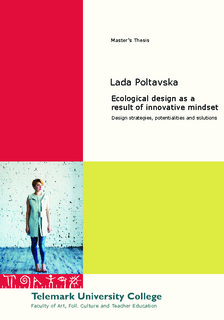| dc.description.abstract | The present project contains two components: theoretical and practical. The central theme of this paper is design and it is mainly oriented toward the analysis of sustainable strategies within ecological design. It includes questions, concerning social responsibility, ethical trade initiatives and brand development processes. In order to research these problems, the project has brief discussions about what ecological design is; what kind of criteria are used to delineate notions; if there is any use in naming it ‘fashion’, and finally what makes eco-brands being called so. My work also includes analysis of three fashion brands – Sølv (Norway), Nurmi (Finland) and Filippa K (Sweden) that are presented as being the most open and reliable in their way. Each of these brands has their own history, beliefs and vision. They use different approaches, but at the same time they have managed to find their own niche and be successful. The project aims to gain a better understanding of ecological design and its aspects through the study of before-mentioned companies. A challenge is to find out, as far as possible what is behind the brand, and whether what they say and what they do is actually the same thing. It also will be about influence towards the costumers and the choices they make. The theoretical framework for this project has been based on the works of leading experts that bring together fashion and technological innovation, looking for new ideas and approaches to sustainability. I refer to research report, provided by M. H. Austgulen and E. Stø for Norwegian National Institute for Consumer Research. The main topic of this paper is the dualism of ecolabels and environmental standards in the global textile market. The reports, submitted by Environmental Justice Foundation, Organic Trade Association, United States Environmental Protection Agency and World Fair Trade Organization are also presented here. I include numerous examples of brands that use different kind of strategies and supply their works with practical solutions and descriptions. The practical part of the project is realized through a collection of clothes, made of natural materials. The main idea of the collection is laid in transformation and ability to restore worn-out pieces easily, expanding the boundaries of long-lasting design. In such a way, I present my own ideas on how materials can be used for clothing to give them a second life in the future. This helps me to find the best solutions for my work and gives me an opportunity to use an experience I have acquired for my further development in Ukraine. | |
